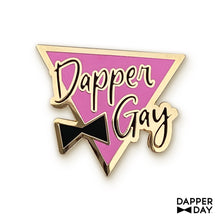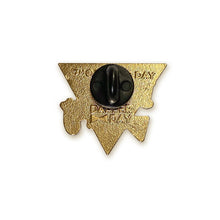For the sharp, well-dressed gay in your life, which might be you!
Designed by DAPPER DAY founder Justin J.
PRODUCT DETAILS:
- Gold finished metal, 1" wide, 1 back post with rubber backer. Fabricated in China.
As festive as it may appear, the bright pink triangle we associate with LGBT+ culture today was born from a horrific time. The symbol began with WWII when the Nazi party developed a system of color-coded labels for people they imprisoned. (Brown triangles were used for Romani people, red for political prisoners, green for criminals, blue for immigrants, purple for Jehovah's Witnesses and black for "asocial" people, including prostitutes and lesbians. Jews were assigned yellow triangles, sometimes overlapping with another to create the Star of David.)
Homosexuality was technically made illegal in Germany long before Hitler, in 1871 with Paragraph 175, a clause in German law prohibiting homosexual relations, but it was rarely enforced until after Germans elected the Nazi Party to power in 1932. The law was expanded by Hitler in 1935 to include kissing and embracing. Convicted offenders – an estimated 25,000 just from 1937 to 1939 – were sent to prison and then later to concentration camps where sentences could include castration, and death.
At the camps, the pink triangles singled out gay men for especially harsh treatment, by both guards and fellow prisoners. “There was no solidarity for the homosexual prisoners; they belonged to the lowest caste,” Pierre Seel, a gay Holocaust survivor, wrote in his memoir I, Pierre Seel, Deported Homosexual: A Memoir of Nazi Terror.
Even after the war ended, gay prisoners liberated from concentration camps were then re-imprisoned – with their time served in the camps not being deducted from their sentences. Both East and West Germany upheld the country’s law against expressions of same-sex affection, and many gay men remained incarcerated until the early 1970s. (The law would remain on the books until 1994.)
In 1972, The Men with the Pink Triangle, the first autobiography of a gay concentration camp survivor, was published. The following year, post-war Germany’s first gay rights organization, Homosexuelle Aktion Westberlin (HAW), reclaimed the pink triangle as a symbol of liberation.
One of the first documented examples of the symbol’s use in the U.S. was at a 1977 protest in Miami where supporters of LGBT+ rights wore the symbol as they rallied (unsuccessfully) against Anita Bryant’s campaign to overturn a law protecting gay people from housing discrimination.
In 1986 a six-person collective in New York created posters which inverted the Nazi’s triangle symbol, pointing upwards on a black background over the phrase SILENCE = DEATH, to call attention to the AIDS pandemic that was killing gay men across the country. The poster was soon adopted by the organization ACT UP and became a lasting symbol of the AIDS advocacy movement.
Today the pink triangle continues to appear in relation to LGBT+ organizations and events. Since the 1990s, signs bearing a pink triangle enclosed in a green circle have been used as a symbol identifying “safe spaces” for LGBT+ people.
With all the advances we have made with civil rights in the U.S. and beyond, I’ve been reminded that those advances remain under constant threat of being revoked, and that LGBT+ people are still feared, and are fearful, around the globe. As of March 2022, being LGBT+ is illegal in 71 nations, and is punishable by death in at least 10.
Increasing the visibility of LGBT+ people – “We’re here, we’re queer! Get used to it!” – remind us all of our substantial population, and creates safer spaces for more people to live freely and not feel shame or the need to hide.
Dapper Day is a gay-owned business.
– J
For more:
https://time.com/5295476/gay-pride-pink-triangle-history/
https://holocaustlearning.org.uk/latest/reclaiming-the-pink-triangle/








